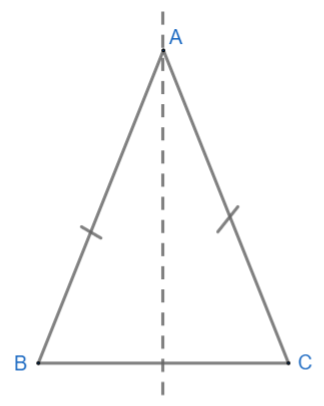
Can you draw a triangle, which has exactly two lines of symmetry? Sketch a rough figure.
Answer
561.9k+ views
Hint: In this question, we have to draw a triangle, which has exactly two lines of symmetry. For this, we will draw three types of triangles based on sides, which are the scalene triangle, isosceles triangle, and equilateral triangle. After that, we will try to draw lines of symmetry of these triangles and check if any of them have exactly two lines of symmetry.
Complete step-by-step solution
Here, we have to draw a triangle, which has exactly two lines of symmetry.
Let us first understand what a line of symmetry is.
A line of symmetry is a line that cuts a shape exactly in half. If we place a mirror along the line, the shape will remain unchanged.
Based on this, we can draw three triangles based on their sides which are the scalene triangle, isosceles triangle, and equilateral triangle.
Now, let us draw these triangles and their possible lines of symmetry.
Scalene triangle: It is a triangle, which has all three sides different.

As we can see, the scalene triangle has no line of symmetry. No line can cut this triangle into exactly two identical parts. So this is not our required triangle.
Isosceles triangle: It is a triangle, which has two sides equal. (AB = AD in triangle ABC).

As we can see, this triangle has only one line of symmetry. So, this is not our required triangle.
Equilateral triangle: It is a triangle which has all sides equal. (AB = AC = BC in triangle ABC).

As we can see, this triangle has exactly three lines of symmetry. So this is not our required triangle.
Hence, there exists no triangle with exactly two lines of symmetry.
Note: Students should take care that the line of symmetry creates two shapes which are mirror images of each other. We are not talking about the area here. If we had to draw any shape having exactly two lines of symmetry then the rectangle is our required shape. Students should note that we classify only three types of triangles based on sides.
Complete step-by-step solution
Here, we have to draw a triangle, which has exactly two lines of symmetry.
Let us first understand what a line of symmetry is.
A line of symmetry is a line that cuts a shape exactly in half. If we place a mirror along the line, the shape will remain unchanged.
Based on this, we can draw three triangles based on their sides which are the scalene triangle, isosceles triangle, and equilateral triangle.
Now, let us draw these triangles and their possible lines of symmetry.
Scalene triangle: It is a triangle, which has all three sides different.

As we can see, the scalene triangle has no line of symmetry. No line can cut this triangle into exactly two identical parts. So this is not our required triangle.
Isosceles triangle: It is a triangle, which has two sides equal. (AB = AD in triangle ABC).

As we can see, this triangle has only one line of symmetry. So, this is not our required triangle.
Equilateral triangle: It is a triangle which has all sides equal. (AB = AC = BC in triangle ABC).

As we can see, this triangle has exactly three lines of symmetry. So this is not our required triangle.
Hence, there exists no triangle with exactly two lines of symmetry.
Note: Students should take care that the line of symmetry creates two shapes which are mirror images of each other. We are not talking about the area here. If we had to draw any shape having exactly two lines of symmetry then the rectangle is our required shape. Students should note that we classify only three types of triangles based on sides.
Recently Updated Pages
You are awaiting your class 10th results Meanwhile class 7 english CBSE

Master Class 10 General Knowledge: Engaging Questions & Answers for Success

Master Class 10 Science: Engaging Questions & Answers for Success

Master Class 10 Social Science: Engaging Questions & Answers for Success

Master Class 10 Maths: Engaging Questions & Answers for Success

Master Class 10 English: Engaging Questions & Answers for Success

Trending doubts
Convert 200 Million dollars in rupees class 7 maths CBSE

i What trees does Mr Wonka mention Which tree does class 7 english CBSE

What are the controls affecting the climate of Ind class 7 social science CBSE

What was the main occupation of early Aryans of rig class 7 social science CBSE

Write a letter to the editor of the national daily class 7 english CBSE

Welcome speech for Christmas day celebration class 7 english CBSE





